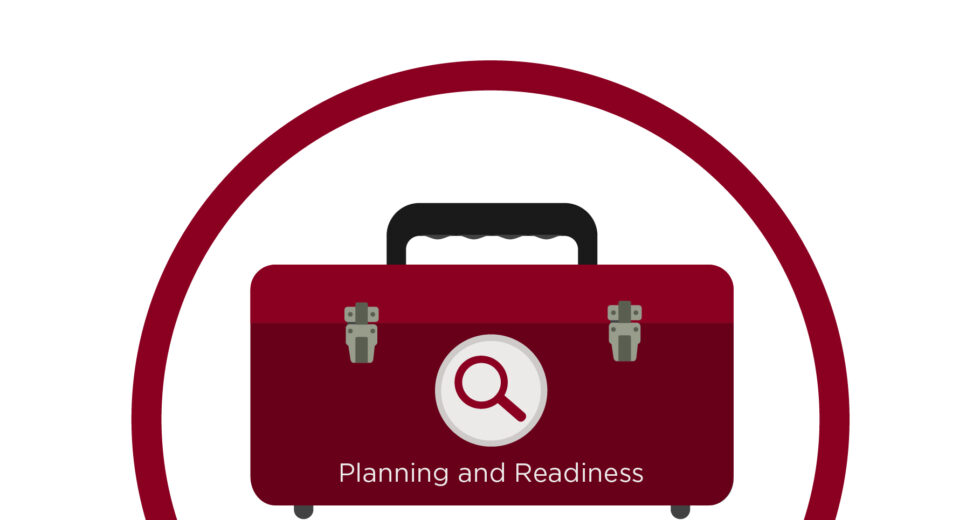Family First Toolkit Part 1: Planning & Readiness

The Family First Prevention Services Act is a unique opportunity to implement more prevention-oriented and family-centered child welfare systems.
The tools in this kit align with the first phase of Family First Implementation: planning and readiness. These Chapin Hall tools provide a systematic way for jurisdictions to think through their vision and plan the activities that will help them reach their goals–from targeting audiences, to engaging stakeholders, to aligning family service plans with the policy. Click through on each tool to view and download. You can also see the tools from part 2 of the toolkit, Implementation and Change Management, and part 3, Evaluating and Improving Quality.
Step 1: Develop strategic direction Step 2: Facilitate stakeholder engagement Step 3: Analyze and visualize data Step 4: Conduct provider surveys
Step 5: Develop prevention plan or other family first plan
Step 1: Develop strategic direction
Key Considerations for Family First Readiness Planning and Initial Implementation: This tool provides a high-level overview of Family First components and key considerations in this initial phase.
Assessment Questions for Family First Readiness Planning and Initial Implementation: This is a companion to the key considerations tool that provides specific questions for leaders and workgroup members to consider about Family First planning and initial implementation.
Theory of Change Template for Title IV-E Prevention Plan: This tool helps identify key aspects of the law that–together with broader transformation efforts–will lead to systems and outcomes improvements.
Conceptualizing Community Pathways: Key Questions and Considerations: This resource is intended to support child welfare agencies and their partners in efforts to co-design community pathways to prevention within the context of Family First.
New Guidance on Community Pathways from the Children’s Bureau: This memo from Chapin Hall and Public Consulting Group highlights key takeaways from new federal guidance on community pathways.
Step 2: Facilitate stakeholder engagement
Governance Structure Examples Deck: Governance structures are important for intentional decision-making, for promoting accountability and for engaging stakeholders. Together, these actions provide a foundation for sustainable change. This tool provides examples of Family First governance structures across jurisdictions.
Family First Background Deck Template: This tool highlights Family First provisions, with specific details about the requirements for prevention. It is a useful overview for internal and external stakeholder groups.
Charter Template: This template includes sections with draft language to develop a charter for a Family First governance structure.
Charter Template slide deck: This is a companion to the charter template that may be used in stakeholder, leadership, or other meetings to walk through development of a charter for an implementation team or workgroup within a Family First governance structure.
Step 3: Analyze and visualize data
Candidacy Deck on Analytical Approaches and Visuals: This tool provides an overview of different approaches to visualizing candidacy for Family First and analytical approaches for eligibility determination.
Candidacy by Jurisdiction: This tool is a compilation of candidacy definitions and considerations from submitted and approved Family First Prevention Plans.
Step 4: Understand service capacity and realign service array
Family First Provider Readiness Assessment Survey Template: This tool includes a survey for providers to assess readiness in areas of service capacity, continuous quality improvement, trauma-informed care, and qualified residential treatment program requirements related to Family First. This template can be tailored to different jurisdictional contexts and uploaded into a survey software for circulation.
Family First Evidence-Based Practices (EBP) Exploration & Cost Tool: This tool provides EBP model overviews, a survey that can be used to match model fit and usability, and budget worksheets to estimate implementation costs based on the projected number of families/children to be served and the number of provider agencies, teams, and individual staff involved.
Title IV-E Clearinghouse Crosswalk: This template helps jurisdictions capture and organize relevant information about potential evidence-based prevention programs to inform intervention selection for the title IV-E prevention services plan.
Step 5: Develop prevention plan or other Family First plan
Family First Prevention Plan Outline Template: This tool provides a section by section outline of the information required to build a narrative for submission of the Family First Prevention Plan.
Family First Prevention Plan Development Activity Outline: This template provides a detailed list of tasks to complete for drafting the prevention plan, aligning tasks in the order that they need to be accomplished and allowing for the insertion of a timeline.
Family First Prevention Plan Section Templates: These tools provide a guide for writing the Prevention Plan, section by section, and provides examples from states’ submitted plans.
- Section 2 Eligibility and Candidacy Identification
- Section 3 Title IV-E Prevention Services
- Sections 4 and 5 Key Considerations for Prevention Plan
- Section 6 Evaluation Strategy and Waiver Request
- Section 7 Child Welfare Workforce Training
- Section 8 Prevention Caseloads
Family First QRTP Work Plan Template: This work plan template provides a guide to sequencing the requirements of Family First qualified residential treatment program.
For more information about these tools or to work with us to implement Family First, email us at FamilyFirstChapin@Chapinhall.org.
 Thank you for your interest in Chapin Hall’s research. Please share some information to access this file.
Thank you for your interest in Chapin Hall’s research. Please share some information to access this file.